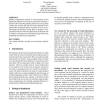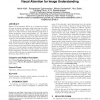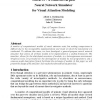6192 search results - page 17 / 1239 » Distributed Control of Attention |
HCI
2009
13 years 5 months ago
2009
An important question for ecologically valid virtual environments is whether cohort characteristics affect immersion. If a method for assessing a certain neurocognitive capacity (e...
CORR
2008
Springer
13 years 7 months ago
2008
Springer
Popular computational models of visual attention tend to neglect the influence of saccadic eye movements whereas it has been shown that the primates perform on average three of th...
MM
2010
ACM
13 years 7 months ago
2010
ACM
Human Visual attention (HVA) is an important strategy to focus on specific information while observing and understanding visual stimuli. HVA involves making a series of fixations ...
AAAI
2012
11 years 10 months ago
2012
We introduce a new task-independent framework to model top-down overt visual attention based on graphical models for probabilistic inference and reasoning. We describe a Dynamic B...
WAPCV
2004
Springer
14 years 28 days ago
2004
Springer
A number of computational models of visual attention exist, but making comparisons is difficult due to the incompatible implementations and levels at which the simulations are con...



